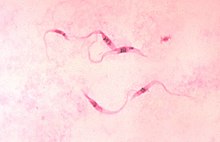
Back ذوات منشأ الحركة Arabic ذوات منشا الحركه ARZ Kinetoplastidlər Azerbaijani Кінетапластыды Byelorussian Cinetoplàstids Catalan Bičivky Czech Kinetoplastea German Kinetoplastea Spanish Kinétoplastidé French Cinetoplástidos Galician
| Kinetoplastida | |
|---|---|

| |
| Trypanosoma cruzi parasites | |
| Scientific classification | |
| Domain: | Eukaryota |
| Phylum: | Euglenozoa |
| Subphylum: | Glycomonada |
| Class: | Kinetoplastea Honigberg, 1963 emend. Cavalier-Smith, 1981[1][2] |
| Subdivisions | |
| Synonyms | |
| |
Kinetoplastida (or Kinetoplastea, as a class) is a group of flagellated protists belonging to the phylum Euglenozoa,[3][4] and characterised by the presence of a distinctive organelle called the kinetoplast (hence the name), a granule containing a large mass of DNA. The group includes a number of parasites responsible for serious diseases in humans and other animals, as well as various forms found in soil and aquatic environments. The organisms are commonly referred to as "kinetoplastids" or "kinetoplasts".[5]
The kinetoplastids were first defined by Bronislaw M. Honigberg in 1963 as the members of the flagellated protozoans.[1] They are traditionally divided into the biflagellate Bodonidae and uniflagellate Trypanosomatidae; the former appears to be paraphyletic to the latter. One family of kinetoplastids, the trypanosomatids, is notable as it includes several genera which are exclusively parasitic. Bodo is a typical genus within kinetoplastida, which also includes various common free-living species which feed on bacteria. Others include Cryptobia and the parasitic Leishmania.
- ^ a b Honigberg, B. M. (1963). "A contribution to systematics of the non-pigmented flagellates.". In Ludvík, J.; Lom, J.; Vávra J. (eds.). Progress in Protozoology: proceedings of the first International Congress on protozoology held at Prague. Academic Press.
- ^ Cavalier-Smith, T. (1981). Eukaryote kingdoms: seven or nine? Biosystems 14, 461–481.
- ^ Berman, Jules J. (2012). Taxonomic Guide to Infectious Diseases: Understanding the Biologic Classes of Pathogenic Organisms. London: Elsevier/Academic Press. p. 96. ISBN 978-0-12415-895-5.
- ^ "Kinetoplastida (kinetoplasts)". UniProt Consortium. Retrieved 22 January 2015.
- ^ Lukes, Julius (2009). "Kinetoplastida". The Tree of Life Web Project. Retrieved 10 September 2013.